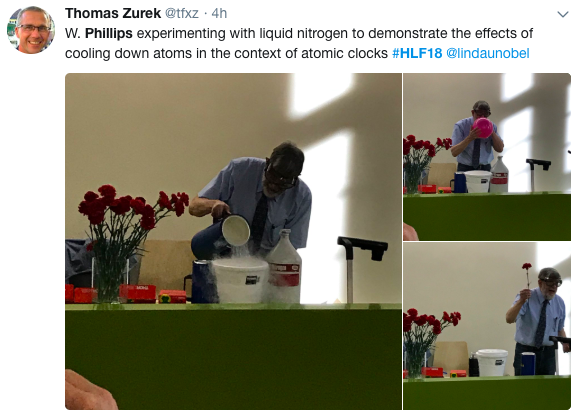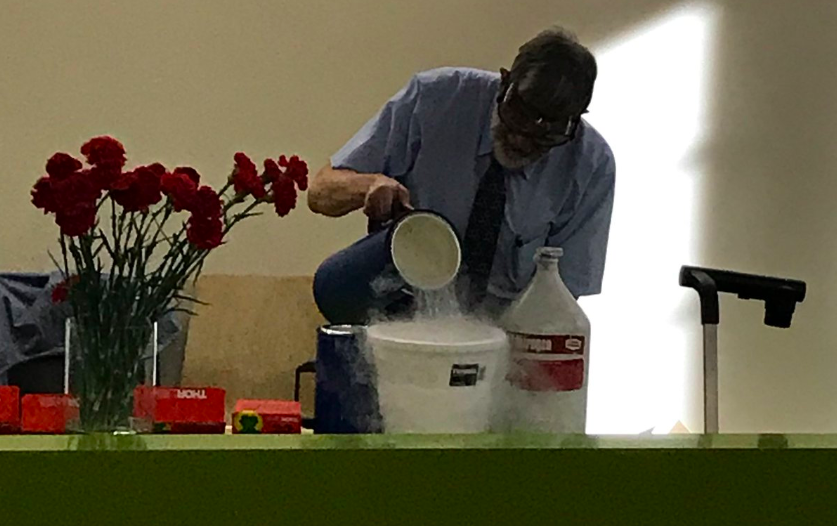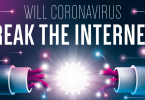Gina Smith penned an earlier version of this piece for Scilogs Spectrum at HLF 2018 in Heidelberg yesterday. Read that here.
Heidelberg — Steer clear of the doors, Nobel physicist Bill Phillips warned us at the outset of his lecture here at the Heidelberg Laureate Forum this morning. And whatever you do, don’t sit in the first two rows of the lecture hall.
These weren’t the first clues that the audience was about to get about as unorthodox a lecture on atomic physics that you could possibly imagine. After all, the HLF 2018 guide listed the title of Phillips’ talk as ‘Time, Einstein and the Coolest Stuff in the Universe.’ But still, the audience of world-famous math and computer science laureates and young researchers that gathers here for the HLF event every year never truly expected what came next.
What followed was a freewheeling exploration that improbably combined physics, humor, performance art, impressive amounts of liquid nitrogen (“the coolest stuff you’ve ever seen!”), balloons, frozen flowers, shattering racquetballs and, yes, even an explosion or two.
Amid a performance that had onlookers like Internet pioneer Vint Cerf, cryptography legend Whitfield Diffie and Google AI chief Jeff Dean grinning throughout, the Cornell-based atomic scientist managed to cogently explain the cooling and trapping of atoms with lasers and exactly why it matters.
Laser atom cooling earned Phillips and colleagues Stanford’s Steve Chu and Collège de France’s Claude Cohen-Tannoudji, the Nobel Prize in physics back in 1997.
Today’s talk focused largely on how that technology is directly leading to the creation of the most accurate atomic clocks ever. But he managed to deliver some memorable insights regarding the future of quantum physics, Einsteinian physics and how atomic cooling might eventually drive quantum computing design.
Hopefully, within his lifetime — but certainly within those of the young researchers in the room, he said — such clocks could even be used to at last confirm Einstein’s equivalence principle, a bedrock of physics.
“It is such an exciting time to be alive!” he shouted exultantly at the end of the speech. And the audience, perhaps predictably at this point, went wild.
A fellow at the National Institute of Standard and Technology, Phillips did follow a main thread thoughout his talk: He described what laser cooling tech is and how it will continue to help NIST to develop and operate the world’s most accurate atomic clocks.
But he didn’t start there. Rather, he started deceptively simply — with the idea of time itself. What is it? And how do we measure it?
“Why is tomorrow always one day away?” he quipped in a classic Yogi Berra deadpan, before singing a bit of ‘Tomorrow’ from the musical, “Annie.”
“Before Einstein,” Phillips said, straightening up a bit, “people thought space and time were just part of an unchanging stage on which events played. But Einstein told us that the stage was part of the action.”
A matter of time
“So what is time? It is simply what a clock measures,” Phillips continued.”But what is a clock? Well, there are many different kinds of clocks … and different clocks have different tickers.” Time is just about how you mention the ticks, he pointed out, and that is true whether those ticks are based on the stars that appear to move as the Earth turns or the tones of a classic Heidelberg-style cuckoo clock.
Watch Phillips’ presentation from HLF 2018 below. Story continues below the video.
But there’s a problem, he said, and that’s that fact “that all of these clocks’ tickers are imperfect. The length of a pendulum may stretch or shrink, and every quartz crystal is a little different from all the others, changing even with heat and humidity as it lies by your bedside. And even the rotation of the Earth is not constant. It is slowed by tides and affected by storms and ocean currents.”
 The development of the atomic clock, which relies on measuring the state of Cesium 133 atoms, is so important for this reason.
The development of the atomic clock, which relies on measuring the state of Cesium 133 atoms, is so important for this reason.
However, as accurate as atomic clocks are — and they are incredibly accurate — they are still imperfect “because they are limited by atomic motion.” That is, Cesium atoms, which move and have their states measured inside an atomic clock tube, cannot be a (near) perfect keeper of time because of that movement.
The coolest stuff in the world
That is why the technology for which Phillips and his team won the Nobel, cooling atoms and trapping them using lasers, has paved the way for ever more perfect clocks.
Phillips work, it’s worth noting, has been credited over the years as a breakthrough discovery — not just for its utility in dramatically improving such applications as atomic clockmaking, but also in such fields as high-resolution spectroscopy, atomic lithography and quantum computing.
Demonstrating the technology to a group of people, however brilliant, with little or no background in the field was a mean feat. He used liquid nitrogen to demonstrate, with great hilarity, the effect of supercooling on moving atoms. In so doing, he turned balloons and flowers into flat, shattering frisbees and, memorably, demonstrated why you never want to put a closed bottle of liquid in the oven — or an NO2 bath.
“Your mother was right, you shouldn’t do that,” he told the group.
Below, watch Phillips describe the discovery that nabbed him the 1997 Nobel Prize in physics. And keep an eye on this space for a link to a video of Phillips’ tour-de-force presentation at HLF 2018. It should be up in a few hours.
For HLF 2018, I’m Gina Smith.
Video: NIST.gov













